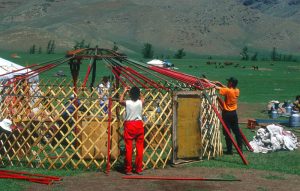Yurts are the ultimate example of efficiency in residential construction. Their structural design, insulation and covering keep them cool in summer, warm in winter, and extremely wind resistant. A yurt’s round walls allow for much less surface area for interior heat to escape while letting the wind move more organically around it instead of pushing against it.
The framing of the support system is completely self-sufficient and a wonder of engineering. The roof is supported by the use of a tension band and compression ring leaving the interior completely open and available to any interior design you could need.
A Brief History of the Yurt
Even though the practicality of yurt design and living didn’t reach the United States until after the second half of the 20th century, the design has been the primary traditional form of housing in Central Asia as far back as the 13th century. Even today in many of the same regions, the Yurt is the only design used in most homes in Mongolia and other Central Asian areas.
Yurts are Especially Friendly to the Environment
Yurts are constructed on a raised platform supported by posts, versus a concrete slab directly on the ground.
When properly anchored, these platforms create very little change to the area they are situated on. Today’s structural beams and fabric coverings are often constructed through environmentally conscious methods and sustainable resources.
The insulation fabrics used take up a very small footprint. Additionally, it’s been reported that people who exhibit chemical sensitivities to other insulation materials used in modern building don’t react adversely to yurt insulation fabrics.
Yurts are Especially Compatible with their Environment
Yurts blend in nicely into whatever environment they are placed in. Their rounded form lends a more organic shape to the dwelling, versus the standard straight lines typical rectangular and square shapes do. The overall appearance provides a much more attractive and serene feel to the residential space.
Yurts Can be Moved and Lived in Just About Anywhere
The construction makes a yurt extremely portable, allowing the owner to transition to just about any area a support platform can be contrasted. This same construction also makes it incredibly strong and able to hold up to strong winds, heavy rain and snow and even earthquakes.
With a yurt you can move from the desert to the beach to the mountaintops, taking your yurt along for the ride in each setting.

Yurts Provide Incredible Flexibility of Use
Since the design of the yurt doesn’t require any interior walls, you have an enormous open space to work with when you start planning the inside. Whether you decide to put in permanent walls, movable dividers or build a loft for even more usable space, there is any number of ways you can use your yurt interior. Smaller ones can be used as workout/yoga studios, guest homes, or even just temperature-controlled storage buildings.
Suggested: Self Reliant Power Source For Your Yurt
Yurts Encourage Inner Healing and Spiritual Enlightenment
The aesthetics of a yurt’s construction, particularly its shape and openness, can be seen in other cultures throughout the globe. Round dwellings can be seen on just about every contentment throughout history, from traditional grass huts in Africa, igloos in the Arctic region, and the Teepees of many Native American tribes.
Their very construction adapts not only to their physical surroundings but naturally allows a freer flow of energy inside and out. These attributes aid in creating a more healing, creative and spiritual environment.
Ready to Change Your Life?
Or at least your home? We’ve touched on just some of the benefits and fun Yurt living can bring to your life. If you are looking for a more efficient and environmentally friendly living space, the yurt should be at the top of your list.







